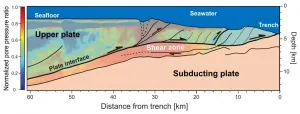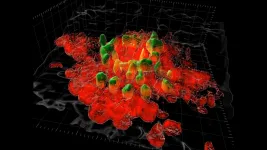But one year, dozens of Zoom meetings, hundreds of phone calls and text messages, thousands of online gaming hours, and millions of social media posts later, new research led by UNLV has found that the tech mediums we once thought were the way of the future actually don't stack up very well against old-fashioned face-to-face communication. At least not in the order we imagined.
"Connecting During COVID-19," a study slated for publication this month in the journal Human Communication & Technology, found that older technologies like voice calls and emails were more effective at easing pandemic loneliness and stress than newer options like video chats, social media, and interactive video games.
"Age, relationship status, and living situation were the three big factors that shifted how people were impacted by tech," said Natalie Pennington, a UNLV communication studies professor and social media expert, who collaborated on the study with University of Kansas professor Jeff Hall and Michigan State University associate professor Amanda Holmstrom. "There's other research out there that said young adults are the biggest concern because older adults are already used to some degree of social isolation. And our study mirrored that: 18- to 29-year-olds comprise the group that's struggling the most with isolation despite the availability of all these communication technologies."
In May 2020, researchers surveyed roughly 2,000 Americans across a wide range of geographic, age, racial/ethnic, educational, and socioeconomic backgrounds about how they use communication technology to meet their social and psychological well-being needs, as well as its impact on their relationships both inside and outside the home. Just barely a month into the pandemic, cell phone companies, internet providers, and video chat and social media platforms all reported huge spikes in traffic, according to data cited within the study.
"Technology can help us, but it does force us to be creative in ways that we might not think of right away," said Pennington, who also completed two solo studies on the topic. She will present her findings later this month at the Central States Communication Association conference. "One of the biggest things that helps is talking and thinking about and doing other things -- family game nights, family dinners, having fun with people during online Netflix parties, or just video chatting with people for a purpose and not talking about the pandemic."
Here, Pennington shares her top 10 most interesting findings from her research on social media and communication technology use during the pandemic.
Top 10 Takeaways
1. The most used and most important types of communication were phone calls and texting. This is consistent with what we know about phone calls during the early days of the pandemic: In April 2020, the number of daily voice calls was twice that of the peak traffic day in 2019.
"It's a nice pushback on our general expectations about video chat having risen up during the pandemic," Pennington said.
2. Phone calls were associated with decreases in stress, loneliness, and relationship maintenance difficulties.
"When I'm on a voice call, I can multitask, move around, and I might not be as stressed as I would if I were having to give 100% of my focus to a video chat," Pennington said. "At the same time, hearing someone's voice can help me feel connected in a way that I might not get from texting."
3. Video chats, on the other hand, were associated with increased levels of stress, loneliness, and relationship difficulties.
"On a theoretical level, you'd think that the richer the medium, the better it is because it can approximate face-to-face communication," Pennington said. "But because video chat tries to be face-to-face when it's not, I think it almost makes you even more sad that you can see the person yet they're not actually there; because you can't get those context clues, those haptics, those things that make us like being in a room with a person."
What's more: Think about the energy required for a video chat--you have to give your full focus, which can make them draining for those not used to the medium. It's no wonder people are talking about "Zoom fatigue." This stands as a good reminder to switch up modalities for what works best for you versus what you think you should be using.
Further study is needed, but Pennington hypothesizes that research will find video chat, while a helpful supplement, isn't a good replacement for in-person interactions.
4. Social media posting, commenting, and sharing was the modality most strongly associated with stress. Early research during the pandemic highlighted an increase in "doomscrolling," which Pennington hypothesizes is connected to her team's finding.
"Not talking about the pandemic is one of the biggest things to help people get through the pandemic," she said. "When you're stressed out, that fixation and rumination while posting and commenting and talking about that stress online can make it worse. Social media can also serve as a reminder of the things you are no longer able to do as you shelter in place, which can make you feel worse."
5. Those in a romantic relationship reported less loneliness and stress compared to those who were not. However, people in romantic relationships were also more likely to experience stress related to social media posting.
"Together, these findings help us see that the types of relationships we're sustaining can help us during the pandemic. But our modality choices, above and beyond, can flip us in the other direction," Pennington said. "The person who is least stressed is in a relationship but not using social media. But the person who's most stressed is in a relationship and is using social media. And the no-relationship, no-social media person is the middle zone."
6. Being sheltered in place created a greater perception of loneliness and stress, and more difficulty with relationship maintenance. This one tracks when you think about the state of the world. Being told you should limit gatherings and stay home, regardless of your usual habits, can lead to more stress, and cause feelings of loneliness when you think about the people you could have been spending time with. The increased difficulty managing relationships likely points to potential stress in the home--finding alone time is important to help balance needs and avoid difficulties.
"In a separate qualitative study I'm working on, it came up over and over that there's lots of tension in some households because suddenly there are multiple people in each other's space all the time. And," she added, "preliminary findings from another study suggest that it's leading to relational burnout for some people."
7. At the same time, living alone was unassociated with loneliness and maintenance difficulties, suggesting having someone in the house doesn't always help (especially since it was also associated with less stress).
"You can feel cooped up with people around you, once again pointing to the importance of some alone time," she said.
8. You've got mail!
Older and middle-aged adults were able to make use of email as a way to decrease loneliness, while young adults (under 29) experienced increased loneliness alongside the use of email. One reason for this may be familiarity with and preference for letter-writing: Younger generations may perceive email as a poor substitute for interaction, while older and middle-aged adults may find comfort in the nostalgic structure that email provides to connect with loved ones.
"Some people love it, some people hate it, and I think age has something to do with that," Pennington said, "because younger people tend to associate email with work. So, trying to make use of it in a social way, especially when it's one of the leanest forms of communication that just relies on text, means it's not for everyone."
9. Online gaming was associated with greater stress and more relational maintenance challenges. The survey didn't delve into the reasons why. But Pennington posits that it may be that in people's attempts to escape their pandemic realities via online gaming, they left their emotional needs and social connections unattended. As a result, they perhaps felt more challenges in their day-to-day communication with other people.
The correlations surrounding online gaming were especially interesting given that gaming consoles sold out during the early days of the pandemic, said Pennington: "There was a drive to do these things, but connecting online seemed to make people more stressed."
10. Face-to-face communication wins out.
Nothing can really replicate face-to-face interactions -- or at least not the modes of communication analyzed in Pennington's study. Across the board, her team found that people who engaged in face-to-face interactions were the least stressed and lonely.
"This is a good reminder and encouragement that in order to get our social needs met, we want to take active steps to be safe and smart, and stop the spread of COVID-19," Pennington said, "so that meeting in person is a viable option going forward."
INFORMATION:






